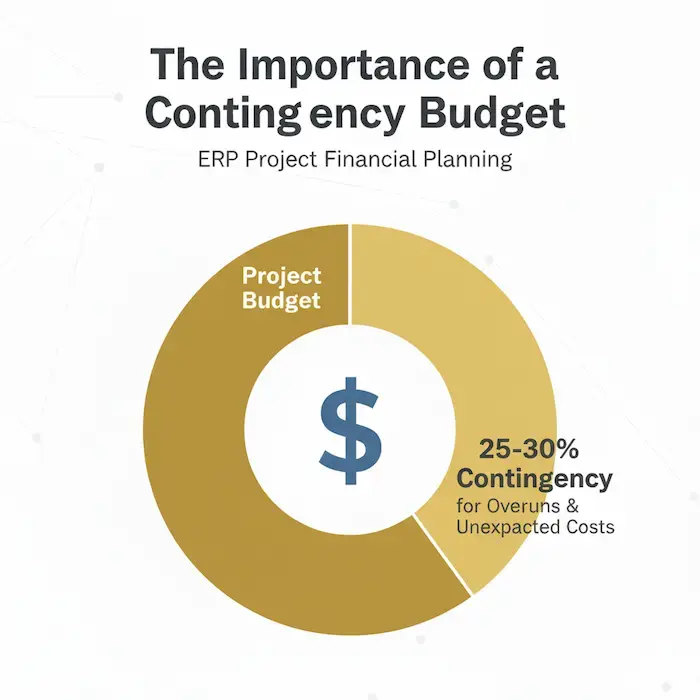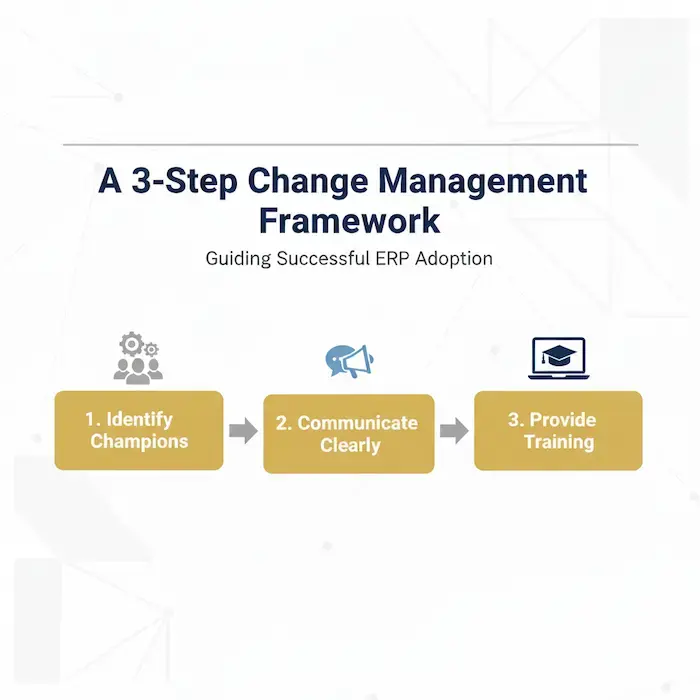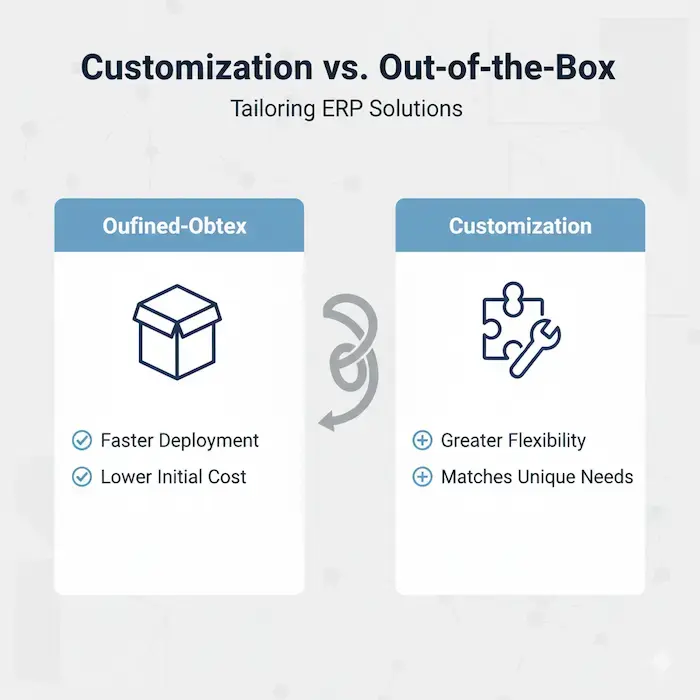Implementing an ERP system can transform how a company manages its operations, but the ERP implementation process often presents serious hurdles. From unexpected budget overruns to data migration complications and change resistance, the road to a successful ERP implementation is rarely smooth.
This guide explores the most common ERP implementation challenges and outlines practical, proven solutions to help you plan a structured, efficient, and effective ERP implementation.
Whether you're just starting or reevaluating your current strategy, understanding these roadblocks can make the difference between failure and a successful implementation that drives real business value.
Key Takeaways
- ERP implementations often experience significant budget overruns, necessitating thorough project planning and the engagement of key stakeholders to estimate costs accurately.
- Executive sponsorship is crucial for ERP success, with strong leadership involvement associated with higher project success rates and fewer implementation failures.
- Effective change management, comprehensive training, and clear communication are essential to mitigate resistance and ensure user adoption during ERP implementation.
High Costs and Budget Overruns

Managing costs remains one of the most frequent and disruptive challenges in ERP implementation. Many ERP projects exceed their budgets due to poor forecasting, misalignment between departments, and failure to anticipate hidden implementation costs.
One primary cost driver is data migration, especially when transferring from outdated legacy systems. Training expenses are also frequently underestimated, and the lack of early input from key stakeholders leads to rework and delays.
Another critical issue is scope creep, where new features are added mid-project without proper planning. This often pushes teams beyond both their budgets and deadlines.
To overcome this, organizations should begin with a thorough review of their business processes. This ensures a clear understanding of needs before engaging vendors or building the system.
Next, involve key stakeholders from the start. Their insight helps:
- Prioritize features that align with business objectives
- Identify resource gaps before they become costly
- Set realistic expectations around deliverables and timelines
A well-structured project plan should include a 25–30% contingency budget to manage minor cost overruns and technical obstacles that may arise during the implementation phase.
Using internal resources can help lower overall costs. However, partnering with an experienced ERP consultant brings added expertise. These professionals support budgeting, risk assessment, and planning accuracy across the whole ERP implementation project.
To guide your financial planning, explore our ERP implementation checklist. It outlines practical steps for building a project budget that stays on track.
Securing Executive Sponsorship
One of the most overlooked yet critical ERP implementation challenges is the absence of strong executive sponsorship. It’s a factor behind many failed ERP implementation projects, even when companies follow an established ERP implementation methodology.
Without leadership backing, it becomes difficult to resolve conflicts, maintain focus, or align the project with strategic business processes. Team engagement falters, internal momentum fades, and budget overruns become harder to control.
This challenge is especially damaging because it weakens collaboration between departments and delays decisions at key moments in the implementation phase. The result is often a stalled or misaligned project that never reaches a successful implementation.
To overcome this, companies need an executive-level sponsor who is fully invested in the enterprise resource planning rollout's success.
A strong sponsor ensures that the project:
- Remains aligned with high-level business objectives
- Receives necessary resources at the right time
- It is clearly prioritized within the organization
- Keeps all key stakeholders and functional groups engaged
The sponsor also plays a central role in communicating project milestones and promoting visibility. This top-down support drives accountability and inspires confidence throughout the team, which is critical for gaining commitment and achieving a successful implementation.
Many organizations find that engaging an experienced ERP implementation partner helps define leadership roles and secure strategic buy-in.
Executive sponsorship is not just a box to check. It’s one of the core drivers of success in overcoming the most common ERP implementation challenges and delivering lasting value from your ERP implementation project.
Managing Change Effectively

Change resistance remains one of the most persistent implementation challenges in any ERP implementation project. Even with the right technology, projects fail when employees hesitate to adopt the new ERP system. This often stems from fear of job loss, disruptions to daily routines, or a lack of confidence in the enterprise resource planning solution itself.
These people-related challenges are frequently overlooked during planning. As a result, the system may go live, but its full potential is never realized due to low usage and minimal buy-in. In fact, resistance to change is a leading cause behind delays and poor outcomes in otherwise well-executed ERP projects.
To overcome this, organizations need to treat user adoption as a core part of the ERP implementation methodology, not an afterthought.
Start by identifying internal champions across departments. These individuals can communicate benefits, answer questions, and ease the transition for peers. Then, develop a change management plan that includes:
- Regular communication tailored to different roles
- Clear messaging about how the system improves everyday business processes
- Transparent timelines, expectations, and available support
Most importantly, offer comprehensive, function-specific training programs. A tailored approach ensures each team understands how the system affects their specific workflows and responsibilities
Training should begin early and continue beyond go-live to support evolving needs and maximize user adoption.
To further strengthen internal support, consider conducting a Business Impact Analysis. This helps teams anticipate how the new ERP will affect current tasks, making it easier to adjust proactively.
For help navigating change-related roadblocks, explore our guide to Odoo customization vs. standard features, which explains how to align the system design with user comfort and operational clarity.
When resistance is addressed directly, adoption improves, engagement grows, and the entire organization moves more confidently toward a successful implementation.
Data Migration and Quality Issues

Data migration is one of the most underestimated elements of an ERP implementation project. When handled poorly, it leads to inaccurate data, faulty reporting, and disruptions to essential business processes.
Many of these issues arise when outdated or inconsistent records are moved from legacy systems to a new ERP. Even after a system goes live, poor data quality can impact day-to-day operations and strategic decision-making. These implementation challenges are often overlooked during planning, but they account for a significant share of ERP implementation failures.
To prevent this, organizations must prioritize data as a strategic asset.
Begin with a full audit of all relevant datasets. Clean, validate, and organize records before migration begins. This reduces risks and improves the accuracy of your reporting and workflow automation in the new system.
To strengthen your approach, be sure to:
- Define acceptable standards for clean, usable ERP data
- Engage a cross-functional project team early to align on requirements
- Include multiple rounds of testing and user validation
- Build migration timelines directly into your project plan
- Use tools that support a smooth transfer from legacy systems
Many organizations benefit from dedicated data leads within departments who ensure accuracy and readiness. If you're unsure how to prepare for large-scale data transfer, our guide on fixing broken Odoo installations offers insights into resolving integration and data-related issues during ERP rollout.
Investing in your data early ensures a smoother transition, stronger adoption, and a more successful implementation in the long run.
Vendor Selection and Management
Choosing the right ERP vendor is one of the most impactful decisions in any ERP implementation project. In fact, vendor-related mistakes account for a significant share of ERP implementation challenges, including misalignment, delayed delivery, and unmet expectations.
This process should never be rushed. Successful vendor selection starts with a clear understanding of your internal business processes and operational requirements. When this foundation is missing, teams may choose tools that look promising but fail to support real-world needs.
A strong selection process should always involve key stakeholders from across the business. Their input helps ensure that both technical and operational priorities are considered from the start.
Helpful steps include:
- Defining must-have features and success criteria
- Conducting reference checks and reviewing case studies
- Negotiating terms that support scalability and future needs
- Establishing clear communication expectations with vendors
- Scheduling ongoing performance reviews and support evaluations
Some teams also benefit from using a scoring model to objectively compare vendors. This adds structure to the decision-making process and helps prevent bias or hasty choices.
Cudio helps businesses evaluate and choose vendors who align with their goals, culture, and system requirements. As an experienced Odoo implementation partner, we guide teams through the whole selection and setup process, from technical planning to user onboarding.
For more guidance on evaluating options effectively, this overview of choosing the ideal Odoo ERP implementation partner outlines key steps to reduce risk and improve outcomes.
Customization vs. Out-of-the-Box Solutions

Choosing between a standardized ERP setup and a customized one is a critical decision during the ERP implementation project. Both approaches offer value, but the right choice depends on your organization’s complexity, goals, and internal capabilities.
Out-of-the-box systems come preconfigured with widely used business processes. They are ideal for organizations looking for faster deployment, easier upgrades, and predictable performance. This option often leads to a smoother rollout, especially when business needs align with standard features.
Customization offers greater flexibility. It becomes necessary when internal functional groups require unique workflows or deeper automation. However, too much customization introduces risk. Overbuilding systems adds unnecessary complexity, slows down future upgrades, and can create long-term maintenance burdens.
A balanced approach works best. Customization should be limited to areas that bring measurable improvements or solve specific operational gaps.
To manage customization effectively:
- Define and prioritize requirements with input from business users
- Maintain documentation and version control
- Involve technical leads and process owners early
- Ensure clear communication between teams throughout the implementation phase
Customization should serve the business, not complicate it. Cudio’s approach to Odoo customization focuses on enhancements that streamline workflows while keeping the new ERP system easy to scale and support over time.
For a deeper look at how to evaluate your customization needs, this comparison of Odoo customization vs. standard features highlights where flexibility makes sense, and where simplicity delivers better long-term results.
Done right, customization extends the value of your ERP without compromising system stability or user experience.
Comprehensive Training Programs
A well-executed training program is one of the most essential factors in a successful ERP implementation. Many organizations underestimate the impact of training until it becomes a barrier to progress and user adoption.
When users don’t fully understand how to work within the new ERP system, productivity drops, confidence erodes, and resistance to change increases. In some cases, teams rely on outdated processes simply because they don’t know how to use the system effectively.
To avoid this, training must be more than a single workshop or post-launch session. It should be built into the ERP implementation project from the beginning and evolve with each phase.
Strong training programs typically include:
- Early onboarding during system design and testing
- Department-specific sessions tailored to real tasks
- Ongoing support and learning resources after go-live
- Precise scheduling and dedicated time for user participation
Involving your project team and key functional groups in training design ensures content is relevant and actionable. Teams are more likely to engage with material that reflects their daily work.
Cudio supports clients by embedding training throughout the implementation process, not just at the end. We help teams prepare through hands-on practice, live sessions, and scenario-based learning that reinforces system usage from day one.
For teams planning to use features like customer tracking or sales pipelines, platforms like Odoo CRM become even more powerful when employees are fully trained to use them effectively.
Investing in comprehensive training sets your people up for success, boosts user adoption, and increases the value of your ERP over time.
Avoiding Scope Creep

One of the most frequent and costly ERP implementation challenges is scope creep. It occurs when new features, requests, or requirements are added mid-project, often without fully evaluating the impact.
As the project team works to deliver on shifting expectations, deadlines extend, budgets grow, and critical priorities get pushed aside. This turns a clear roadmap into a moving target, making successful delivery a much more challenging task.
Preventing scope creep requires discipline, structure, and buy-in across all levels, especially from top management.
Here’s what helps teams stay on track:
- Define the scope clearly from the start
- Identify essential features versus future enhancements
- Create a formal change request process
- Review changes with business leads before making adjustments
- Reinforce priorities in weekly status meetings
Clear boundaries do not mean your ERP system cannot evolve. They protect your timeline and budget, allowing your new solution to be implemented with confidence.
Cudio supports clients in managing scope by focusing on early alignment and decision clarity. Our team works closely with department leads to define what matters most and ensure that change requests are evaluated against the broader project goals.
When teams maintain control of scope, the system launches faster, and user adoption improves because users are not overwhelmed by incomplete or unstable features.
Ongoing Support and Maintenance
Going live with a new solution is only the beginning. Long-term success depends on the level of care and support the system receives after deployment.
Without regular updates, maintenance, and user feedback, even the most well-planned ERP implementation project can drift off course. Data quality issues, performance slowdowns, and limited user engagement can surface months after launch if there is no post-go-live strategy in place.
Monitoring and support are not just technical tasks. They are essential to sustaining user adoption, optimizing processes, and keeping the system aligned with evolving business needs.
Key areas of focus include:
- Tracking system performance metrics regularly
- Addressing bugs or usability concerns reported by users
- Reviewing business processes to identify new improvement opportunities
- Updating documentation and training as the system evolves
Ongoing support is often seen as overhead, but it is vital to prevent downtime and protect data integrity. For many companies, maintaining the system is challenging without a clear structure and dedicated resources.
This is where Cudio continues to support its clients. Our post-implementation services include regular system reviews, troubleshooting, and guided enhancements. Whether you're planning an Odoo upgrade or need to fine-tune performance, we help keep your ERP environment running smoothly.
Schedule Your Free Consultation Today
Top management also plays a role in long-term success. Leaders should stay engaged, review KPIs, and ensure that support remains a priority. Their involvement keeps momentum going and reinforces a culture of continuous improvement.
With consistent monitoring, responsive support, and alignment with leadership, your ERP platform becomes more than just software. It becomes a stable foundation for scaling operations and driving future growth.
Realistic Timelines and Testing Buffers
Setting a realistic project timeline is one of the most overlooked aspects of an effective ERP implementation project. Many businesses underestimate the time required to build, test, and stabilize a new system, which leads to delays and incomplete launches.
Statistics show that only a small percentage of ERP projects go live on schedule. This is often due to scope changes, last-minute fixes, or the discovery of incomplete or inaccurate data during final validation.
To reduce risk and deliver a stable ERP solution, timelines should include dedicated space for testing, review, and post-launch adjustment.
A well-structured timeline includes:
- A clear delivery schedule with milestones
- Pilot testing to uncover system gaps and integration issues
- Testing buffers to catch data inconsistencies or configuration problems
- A 3–9 month stabilization period for post-launch refinements
These steps help identify issues that could otherwise interrupt workflows or introduce errors that affect business processes after go-live.
Equally important is assembling a skilled and committed project team. This team should include both technical leads and department-level users. Cross-functional collaboration between IT and operational teams ensures smoother adoption and faster issue resolution related to system performance or financial data workflows.
Working with an experienced ERP consultant helps validate your timeline, build in risk controls, and ensure all moving parts come together effectively. Cudio acts as the right ERP implementation partner, assisting businesses to balance speed with precision across every phase of the project.
As the ERP project team plans the rollout, it’s also important to communicate progress clearly to all stakeholders. Visibility builds trust and prevents last-minute surprises that can derail momentum.
A realistic approach to scheduling, supported by thorough testing and thoughtful planning, not only improves go-live success but also ensures that the new system performs as intended from day one.
Summary
Implementing an ERP system is a complex process that touches every part of a business. From setting realistic budgets to managing data, training teams, and preventing scope creep, each phase brings unique challenges that require thoughtful coordination.
Success depends not only on choosing the right software but also on how well your organization prepares, adapts, and executes. With strong leadership, clear communication, and a plan that supports both people and processes, an ERP rollout becomes more manageable and delivers measurable value.
Cudio works alongside businesses through every phase of the ERP journey. Whether you're migrating to Odoo, building a tailored workflow, or stabilizing a new system, our team helps reduce risk, improve adoption, and create solutions that align with your goals.
ERP implementation is not easy. But with the proper structure, support, and expertise, your organization can move forward with confidence and unlock long-term growth.
Schedule Your Free Consultation Today
Frequently Asked Questions
Clear answers to common ERP implementation questions to help you plan, launch, and succeed with confidence.
What are some common reasons for budget overruns in ERP implementations?
Budget overruns in ERP implementations often occur due to time and resource misestimates, data migration complications, and underestimates of staffing needs. Addressing these areas proactively can help mitigate potential financial discrepancies.
How important is executive sponsorship in ERP implementations?
Executive sponsorship is vital in ERP implementations, as it not only removes obstacles but also secures middle management's commitment, significantly impacting the project’s success. Without strong executive support, the risk of failure increases markedly.
What role does change management play in successful ERP implementations?
Change management is essential for successful ERP implementations, as it fosters employee buy-in, minimizes resistance, and ensures a smooth transition throughout the process.
Why is data migration a significant challenge in ERP implementations?
Data migration poses a significant challenge in ERP implementations because inadequate data transfer can disrupt operations and result in inaccurate reporting, contributing to nearly 38% of ERP failures. Ensuring a seamless migration process is crucial for successful ERP deployment.
How can organizations avoid scope creep in ERP projects?
To avoid scope creep in ERP projects, organizations should establish clear project deliverables, timelines, and costs from the outset, and implement a structured change request process. This approach ensures that any changes are managed effectively, keeping the project on track.





